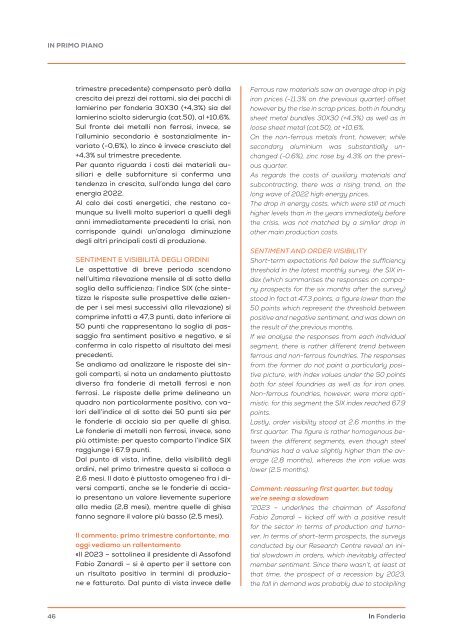In Fonderia 3 2023
Terzo numero del 2023 di In Fonderia
Terzo numero del 2023 di In Fonderia
Create successful ePaper yourself
Turn your PDF publications into a flip-book with our unique Google optimized e-Paper software.
IN PRIMO PIANO<br />
trimestre precedente) compensato però dalla<br />
crescita dei prezzi dei rottami, sia dei pacchi di<br />
lamierino per fonderia 30X30 (+4,3%) sia del<br />
lamierino sciolto siderurgia (cat.50), al +10,6%.<br />
Sul fronte dei metalli non ferrosi, invece, se<br />
l’alluminio secondario è sostanzialmente invariato<br />
(-0,6%), lo zinco è invece cresciuto del<br />
+4,3% sul trimestre precedente.<br />
Per quanto riguarda i costi dei materiali ausiliari<br />
e delle subforniture si conferma una<br />
tendenza in crescita, sull’onda lunga del caro<br />
energia 2022.<br />
Al calo dei costi energetici, che restano comunque<br />
su livelli molto superiori a quelli degli<br />
anni immediatamente precedenti la crisi, non<br />
corrisponde quindi un’analoga diminuzione<br />
degli altri principali costi di produzione.<br />
SENTIMENT E VISIBILITÀ DEGLI ORDINI<br />
Le aspettative di breve periodo scendono<br />
nell’ultima rilevazione mensile al di sotto della<br />
soglia della sufficienza: l’indice SIX (che sintetizza<br />
le risposte sulle prospettive delle aziende<br />
per i sei mesi successivi alla rilevazione) si<br />
comprime infatti a 47,3 punti, dato inferiore ai<br />
50 punti che rappresentano la soglia di passaggio<br />
fra sentiment positivo e negativo, e si<br />
conferma in calo rispetto al risultato dei mesi<br />
precedenti.<br />
Se andiamo ad analizzare le risposte dei singoli<br />
comparti, si nota un andamento piuttosto<br />
diverso fra fonderie di metalli ferrosi e non<br />
ferrosi. Le risposte delle prime delineano un<br />
quadro non particolarmente positivo, con valori<br />
dell’indice al di sotto dei 50 punti sia per<br />
le fonderie di acciaio sia per quelle di ghisa.<br />
Le fonderie di metalli non ferrosi, invece, sono<br />
più ottimiste: per questo comparto l’indice SIX<br />
raggiunge i 67.9 punti.<br />
Dal punto di vista, infine, della visibilità degli<br />
ordini, nel primo trimestre questa si colloca a<br />
2,6 mesi. Il dato è piuttosto omogeneo fra i diversi<br />
comparti, anche se le fonderie di acciaio<br />
presentano un valore lievemente superiore<br />
alla media (2,8 mesi), mentre quelle di ghisa<br />
fanno segnare il valore più basso (2,5 mesi).<br />
Il commento: primo trimestre confortante, ma<br />
oggi vediamo un rallentamento<br />
«Il <strong>2023</strong> – sottolinea il presidente di Assofond<br />
Fabio Zanardi – si è aperto per il settore con<br />
un risultato positivo in termini di produzione<br />
e fatturato. Dal punto di vista invece delle<br />
Ferrous raw materials saw an average drop in pig<br />
iron prices (-11.3% on the previous quarter) offset<br />
however by the rise in scrap prices, both in foundry<br />
sheet metal bundles 30X30 (+4.3%) as well as in<br />
loose sheet metal (cat.50), at +10.6%.<br />
On the non-ferrous metals front, however, while<br />
secondary aluminium was substantially unchanged<br />
(-0.6%), zinc rose by 4.3% on the previous<br />
quarter.<br />
As regards the costs of auxiliary materials and<br />
subcontracting, there was a rising trend, on the<br />
long wave of 2022 high energy prices.<br />
The drop in energy costs, which were still at much<br />
higher levels than in the years immediately before<br />
the crisis, was not matched by a similar drop in<br />
other main production costs.<br />
SENTIMENT AND ORDER VISIBILITY<br />
Short-term expectations fell below the sufficiency<br />
threshold in the latest monthly survey: the SIX index<br />
(which summarises the responses on company<br />
prospects for the six months after the survey)<br />
stood in fact at 47.3 points, a figure lower than the<br />
50 points which represent the threshold between<br />
positive and negative sentiment, and was down on<br />
the result of the previous months.<br />
If we analyse the responses from each individual<br />
segment, there is rather different trend between<br />
ferrous and non-ferrous foundries. The responses<br />
from the former do not paint a particularly positive<br />
picture, with index values under the 50 points<br />
both for steel foundries as well as for iron ones.<br />
Non-ferrous foundries, however, were more optimistic:<br />
for this segment the SIX index reached 67.9<br />
points.<br />
Lastly, order visibility stood at 2.6 months in the<br />
first quarter. The figure is rather homogenous between<br />
the different segments, even though steel<br />
foundries had a value slightly higher than the average<br />
(2.8 months), whereas the iron value was<br />
lower (2.5 months).<br />
Comment: reassuring first quarter, but today<br />
we’re seeing a slowdown<br />
“<strong>2023</strong> – underlines the chairman of Assofond<br />
Fabio Zanardi – kicked off with a positive result<br />
for the sector in terms of production and turnover.<br />
<strong>In</strong> terms of short-term prospects, the surveys<br />
conducted by our Research Centre reveal an initial<br />
slowdown in orders, which inevitably affected<br />
member sentiment. Since there wasn’t, at least at<br />
that time, the prospect of a recession by <strong>2023</strong>,<br />
the fall in demand was probably due to stockpiling<br />
46<br />
<strong>In</strong> <strong>Fonderia</strong>














